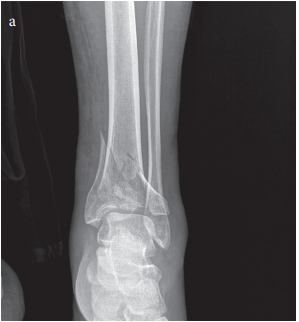Objective: The aim of this study was to evaluate the long-term follow-up and functional and radiological outcomes of minimally invasive medial plate osteosynthesis in distal tibia fractures.
Methods: From January 2011 to November 2015, we reviewed the medical records of 60 patients with 62 tibia fractures (41 men and 19 women; mean age: 45.3±14.9 years) who were treated with open reduction and internal fixation for distal tibia pilon fractures. The mean follow-up time after surgery was 42.7±4.6 months. Union time, coronal plan deformity, complication rates and AOFAS and Olerud-Molander functional outcome scores were evaluated.
Results: According to the AO/OTA classification, there were thirty four (54.8%) type 43-A fracture, eight (12.9%) type 43-B fractures, twenty (32.3%) type 43-C fractures. The average time for fracture union was 16.1 weeks. The mean AOFAS score was 86.6±9.1. The mean Olerud-Molander score was 85.6±9.8. There were four patients (6.5%) with a varus of less than 5°, two patients (3.2%) with a valgus of less than 5°, 39 patients (62.9%) with recurvatum (34 of them less than 5°; five of them less than 10°), and 14 patients (22.6%) with procurvatum (12 of them less than 5°; two of them less than 10°). The AOFAS and Olerud-Molander scores in the smoker and diabetic patients were significantly lower than the non-smoker (p=0.002; p=0.005) and non-diabetic patients (p=0.022, p=0.002). The duration of union was significantly higher in both diabetic (p=0.025) and smoker patients (p=0.041). There was no association between the fracture type and the presence of varus, valgus, recurvatum and rotation deformity. The AOFAS score, Olerud-Molander score and plantar-flexion were significantly higher in type A fractures than in type C fractures (p=0.021; p=0.030, and p=0.033, respectively). AOFAS score, Olerud-Molander score, plantar-flexion value did not differ between type B and type C fractures. There was no significant difference among the dorsi-flexion (p=0.211), the follow-up time (p=0.531) and duration of union (p=0.908) of type A, type B and type C fractures. Three patients with open fracture had delayed wound healing. One patient developed skin necrosis. They were treated by local wound care.
Conclusion: Minimally invasive medial plate osteosynthesis is a reliable method of treatment for tibial pilon fractures. This technique provides a high fracture healing rate and satisfying functional outcome with minimal wound healing complications. Sagittal plan deformity remains a common complication with minimally invasive medial plate osteosynthesis.
Level of Evidence: Level IV, Therapeutic Study
Cite this article as: Barış A, Çirci E, Demirci Z, Öztürkmen Y. Minimally invasive medial plate osteosynthesis in tibial pilon fractures: Longterm functional and radiological outcomes. Acta Orthop Traumatol Turc 2020; 54(1): 20-6.



.png)
.png)

